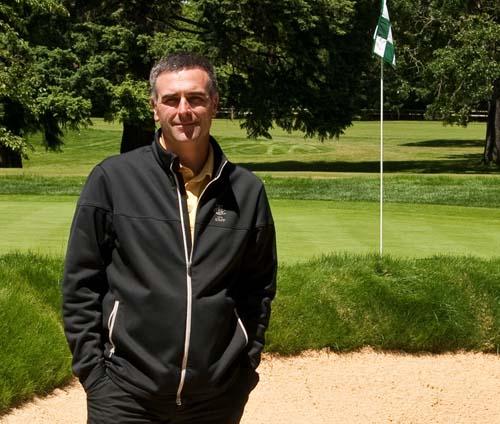 Golf course superintendents love removing trees that rob turf of precious sunlight and air movement. But promoting tree growth? It's difficult to find a superintendent who can get behind that movement.
Golf course superintendents love removing trees that rob turf of precious sunlight and air movement. But promoting tree growth? It's difficult to find a superintendent who can get behind that movement. Promoting a habitat friendly to the Oregon white oak, however, has become a passion for Joel Kachmarek, superintendent at Tacoma Country and Golf Club in Lakewood, Washington. The only oak tree species native to Washington, the Oregon white oak is being pushed out of its natural range by the aggressive Douglas fir. In fact, the Oregon oak is just one of many native species being pushed around by the "Doug fir".
Dozens of species of flora and fauna are in danger of losing their habitat to the Douglas fir, an aggressive native species that first was found in British Columbia in 1791 and can grow to heights of nearly 250 feet.
Kachmarek is removing Douglas firs from the grounds at Tacoma. He started with 17, including one that was an estimated 100 years old. His plans include taking out about 150 more over the next several years.
"It's a new environmental push. We're killing trees to save trees," Kachmarek said. "We want to log out the Doug first because they are shading out everything else.?
 For his environmental efforts, as well as the way he managed a trying (and award-winning) renovation project, in which the architect died midstream, and more at Tacoma, Kachmarek has been named a finalist for the 2014 TurfNet Superintendent of the Year Award, presented by Syngenta.
For his environmental efforts, as well as the way he managed a trying (and award-winning) renovation project, in which the architect died midstream, and more at Tacoma, Kachmarek has been named a finalist for the 2014 TurfNet Superintendent of the Year Award, presented by Syngenta.Built more than 100 years ago, the club was moved to its current location on Washington's coastal prairie in 1905. Generations before the club was founded, American Indians in the Pacific Northwest managed the lands through their own controlled burns. The fires kept the invasive fir at bay and allowed the Oregon white oak to flourish since mature specimens have a thick bark that is resistant to fire. This process provided habitat for game, on which the Indians relied for food and clothing.
Since that practice stopped many years ago, the Doug fir has taken over the coastal oak prairie. For years, that included the golf course at Tacoma, which was built on that same coastal prairie. Through the generations, players there have grown accustomed to tree-lined fairways, even though the trees belong in the mountains, not in the prairies below.
"About 200 species of plants and animals are on the verge of extinction due to loss of prairie. We want to save the oak, but our underlying motivation is to produce better golf turf," Kachmarek said.
"We are going for more of the open prairie look now. That is freaking some people out."
If the new look wasn't enough to make some folks at Tacoma sweat, a recent renovation project might have been.
The restoration was drafted and initiated in 2012 by architect John Harbottle III. A Tacoma resident and member of the club, Harbottle seemed like a fitting choice for the project. The restoration was threatened that May when Harbottle died awaiting a flight at Los Angeles International Airport.
"John and I were friends and we worked together on the design concept," Kachmarek said. "We wanted to take the golf course back to its golden age. The course had taken on a modern '80s look, and we wanted to take it back. That included changing from bunkers with manicured edges to classic-style bunkers with furry edges. We did six to show the members, but John died before the sand went in."
Soon after, the club hired Nick Schaan of architect David McLay Kidd's DMK Golf Design, with strict instructions.
"We hired him because he had worked with John," Kachmarek said. "We told him to finish it as if he were John Harbottle, not Nicholas Schaan."
Drafted as a multi-phase, multi-year project, the restoration instead was completed all at once after Harbottle's death. Kachmarek's staff served as a construction crew for about half the work for two reasons - to save money and maintain control of the project. Despite the many hurdles and challenges, the award was recognized by Golf Inc. as Best Renovation of the Year Under $1 million.
"It was sad, it was tragic, it was everything you can imagine," Kachmarek said. "We were going to do 20 bunkers a year for three years. When John died, we decided to do it all in one sweep while his ideas are fresh in our minds. We had to convince the board to give us the whole nut at one time and adopt a new plan.
"To do all that and complete it within one year of John's death was astounding. And we did it for under $500,000. That was a monumental achievement, considering the circumstances involved in the project.
"It was a typical bunker project with problems like no drainage. Now, they look amazing, and they play amazing, and the members are thrilled with them. It was stressful and gratifying all at one time."
Kachmarek is one of 10 finalists for the award. Finalists are chosen by a panel of judges from a field of nominees based on the following criteria: labor management, maximizing budget limitations, educating and advancing the careers of colleagues and assistants, negotiating with government agencies, preparing for tournaments under unusual circumstances, service to golf clientele, upgrading or renovating the course and dealing with extreme or emergency conditions.
The winner will be named Feb. 26 at the Golf Industry Show in San Antonio. Previous winners include: Chad Mark (2013); Dan Meersman (2012); Paul Carter, CGCS (2011); Thomas Bastis, CGCS (2010); Anthony Williams, CGCS (2009); Sam MacKenzie (2008); John Zimmers (2007); Scott Ramsay, CGCS (2006); Mark Burchfield (2005); Stuart Leventhal, CGCS (2004); Paul Voykin (2003); Jeff Burgess (2002); Kip Tyler (2001); and Kent McCutcheon (2000).

